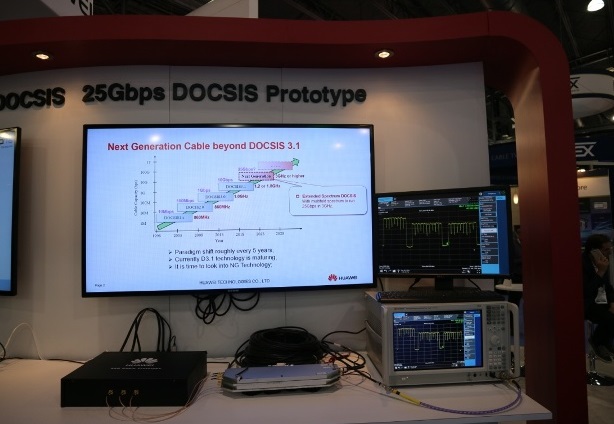Huawei Kicks Tires on 25-Gig DOCSIS

The SCTE/ISBE Cable-Tec Expo wrapped up late last month, but Huawei put out a ICYMI last week to note that it showed off a DOCSIS-based prototype that pumped out a 25 Gigabit per second downstream by raising the usable spectrum to 3GHz
RELATED: Cable-Tec Expo: Attendance Surges Past 10,000
25 Gbps is more than two times the current capacity target of DOCSIS 3.1. Meanwhile, today’s 32-channel DOCSIS 3.0 technology can get within shouting distance of 1.2 Gbps using 6MHz-wide DOCSIS channels.
Huawei noted that its DOCSIS 3.1 prototype supports a maximum downstream rate of 25 Gbps, and a symmetrical rate in the range could likewise be achieved with emerging Full Duplex DOCSIS technology.
Cable-Tec Expo: ‘Full Duplex’ DOCSIS Speeds Ahead
Of course, building out to 3 GHz is something that’s well out on the horizon, if it’s to happen at all. Notably, Vyyo/Javelin Innovations, a now-defunct startup that was once pitched a 3GHz overlay platform, envisioned a day when cable operators would need to raise the spectrum roof to handle increasing demands for bandwidth. At one point, Cox Communications put in orders for 3-GHz passive equipment from Vyyo (with an eye toward business services, but never activated spectrum up in those regions), and StarHub of Singapore once gave the vendor’s spectrum-boosting technology a serious look as a way to enable 1-Gig services.
RELATED: Vyyo Bids for Singapore Broadband Project
Multichannel Newsletter
The smarter way to stay on top of the multichannel video marketplace. Sign up below.
In a recent roundtable with Multichannel News (subscription required), Kevin Hart, EVP and CTO of Cox, which already is built out to 1.2 GHz, doesn’t see spectrum expansion in its near-term future.
“I think in the near-term we’re in good shape without having to widen,” Hart said. “It’s something we’re always evaluating and reviewing. If you’re going to be making some enhancements to the network, it makes good sense to try to future-proof it, but probably not here in the near term on that particular component.”
But Huawei’s 25-gig prototype merely scratches the surface on what kind of speeds engineers believe are theoretically possible over HFC.
Last fall, Arris engineers presented ideas that envision 50 Gbps or more on HFC. But like Huawei’s approach, that would require tapping into spectrum well above 1GHz – perhaps up to 25 GHz to support up to 200 Gbps.
